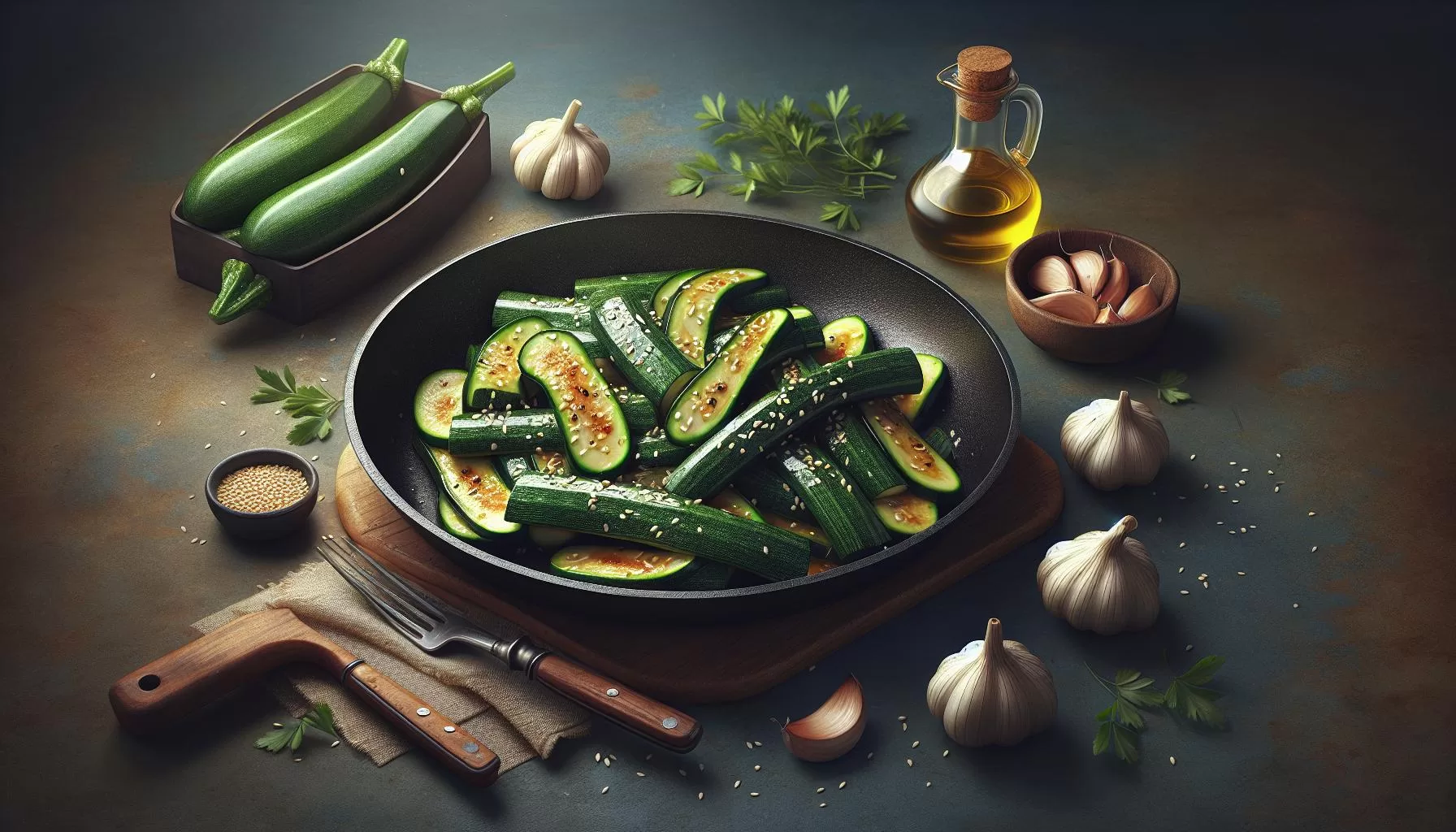Healthy Homemade Hobak Bokkeum Stir Fried Zucchini Recipe for Nutrient-Rich Diet

Ingredients for Homemade Hobak Bokkeum Stir Fried Zucchini
In this middle section, you’ll discover all the ingredients needed to prepare your hobak bokkeum. No advanced preparation required — you’ll need fresh, readily available items from your local store.
First and foremost, get yourself 1 medium-sized zucchini. Ensure it’s vibrant green and firm that’ll assure its freshness. Next up is 1 tablespoon of vegetable oil. You could use olive oil if you prefer; it adds a distinctive taste and stands up well to heat. After that, it’s time for some flavor enhancers. You’ll want 1 tablespoon of soy sauce, 1 teaspoon of minced garlic, and 1 teaspoon of sesame oil.
To add a bit of a kick, you’ll need 1/2 teaspoon of gochugaru. It’s a Korean chili powder that gives the dish its authentic flair. If you can’t find it, cayenne pepper will work in a pinch. Finally, for a bit of texture, fetch 1 teaspoon of sesame seeds and just a pinch of salt for seasoning.
Let’s have a glance at the nutritional value your hobak bokkeum will hold per serving. For keeping track or if you’re fitness conscious, this should serve well.
| Nutrient | Amount |
|---|---|
| Calories | 75 kcal |
| Carbohydrates | 4 g |
| Protein | 2 g |
| Fat | 6 g |
| Vitamins A & C | High |
Now we’ve seen the array of ingredients required for hobak bokkeum, let’s move forward. With these components at the ready, you’re all set to whip up a dish that’ll impress every palate around your kitchen table. A word of caution: please adjust the quantity based on the number of servings you plan to make. It’s all up to you!
Step-by-Step Instructions

To make the unforgettable homemade hobak bokkeum, first, prep your zucchini. Rinse it well, slice off the ends, and cut it into semi-circle shapes of roughly 1/4-inch thickness. Remember, consistency in size will ensure even cooking!
Once your zucchini’s prepped, it’s time to heat your pan. Drizzle in the vegetable oil, and let it get hot on a low flame. If you’re wanting a slightly different taste, you can sub in olive oil at this point. It adds a tasty, unique twist.
After the oil’s hot, add your zucchini slices to the pan. Sauté them on medium heat until they start turning translucent – that’s when you know they’re getting tender.
While your zucchini’s cooking, you can whip up the sauce. In a small bowl, mix together the soy sauce, minced garlic, sesame oil, and gochugaru. Don’t hesitate to reduce or add more gochugaru, depending on your preference for heat.
After your zucchini slices are tender and somewhat translucent, drizzle your sauce over them in the pan. Stir it around to make sure every zucchini piece gets coated.
You’re nearing the end of the cooking process. Season with salt and sprinkle on some sesame seeds for that final touch. By the time you’re done stirring, your hobak bokkeum should be hot and ready for serving.
Of course, food isn’t just about flavor. It’s also about nourishment and feeling good from the inside out. Here is a quick look at the nutritional values you’ll gain from this recipe:
| Nutrient | Amount |
|---|---|
| Calories | 105 kcals |
| Carbs | 11g |
| Protein | 4g |
| Fat | 6g |
| Vitamin A | 15% RDA |
| Vitamin C | 32% RDA |
This recipe proves simple ingredients can create delightful flavors. With its rich array of nutrients, it’s the perfect choice for health enthusiasts! Please adjust the ingredient quantities depending on the desired number of servings.
Tips for Perfecting Your Hobak Bokkeum

Crafting the perfect homemade hobak bokkeum can seem tricky at first. Fear not! With these tips, your stir-fried zucchini will be a household hit in no time.
Choosing and Prepping the Zucchini holds the key to the texture of your hobak bokkeum. Opt for smaller zucchinis. They’re usually sweeter and have softer seeds. Cut your zucchini into even pieces for uniform cooking and better flavor absorption.
When it comes to Cooking Oils, olive oil isn’t your only option. Sesame oil adds a robust, nutty flavor that complements zucchini well. Grapeseed oils and avocado oil are also great alternatives with high smoke points perfect for stir-frying.
Visit your local Asian grocery store if possible. They’ll typically stock different varieties of soy sauce and chili paste that’ll give your hobak bokkeum that authentic Korean flavor. Try experimenting with different types to find one that appeals to your taste the most. Remember, it’s all about what you and your family enjoy.
Don’t toss the Sesame Seeds in without thinking! Toast them lightly before adding them to your hobak bokkeum. It’ll enhance the flavor and provides an inviting, aromatic addition to your dish.
One size doesn’t fit all when it comes to serving sizes. If you’re cooking for more, simply double the ingredients. However, make sure to adapt the cooking times. More ingredients may mean more time needed in the pan.
Being health-conscious doesn’t mean compromising on flavor. Your homemade hobak bokkeum is not only delicious but also filled with nutrients. Look at these benefits!
| Nutritional Element | Per serving |
|---|---|
| Calories | Low |
| Macronutrients | High |
| Vitamins | High |
Feel free to experiment with the recipe by adding your own twists. The beauty of hobak bokkeum is its versatility. Whether it’s adjusting the spice levels, switching up the proteins, or adding an unexpected ingredient, your hobak bokkeum is a reflection of you. Perfecting it doesn’t mean imitating a standard but carving out your unique take. So the next time you fire up the stove, remember these tips and not just cook, but create.
Serving Suggestions

Now that you’ve got a handle on the basics of homemade hobak bokkeum, let’s dive into some serving suggestions that’ll take this dish to new heights.
Pair it with protein: Hobak bokkeum, like many Korean dishes, pairs nicely with a quality protein. Grilled chicken, tofu or even shrimp can add an extra punch of protein to your meal. Considering variety in the protein you pair with your dish not only alters the taste but also amps up the nutritional value.
Mix it with rice: Traditionally hobak bokkeum is served with steamed rice. The tender, sautéed zucchinis blend well with the slightly sticky texture of the rice. It’s important to make sure that the rice is not overly cooked or mushy.
Serve it with kimchi: Authentic Korean meals often include a serving of kimchi as a side dish. The fermented, spicy cabbage of the kimchi, adds an extra kick and rounds out the flavors of the zucchini.
Presentation is key: Aesthetics matter! Remember, people eat with their eyes first. Arrange your hobak bokkeum in a visually pleasing manner. Sprinkle some toasted sesame seeds over the top or garnish it with finely chopped green onions.
Portion size matters: If you’re managing your calorie intake, be aware of the portion size. A single serving of this recipe is rich in vitamins, low in fat, and offers a generous quantity of fiber. It’s the perfect meal for those seeking a balance between taste and health benefits.
Sometimes, the joy of cooking is in the experimentation. With these guidelines, you can make a dish that resonates with your own taste buds and dietary requirements. Remember, these tips are guidelines and not hard and fast rules. So feel free to explore, innovate, and create a personalized version of the hobak bokkeum that’ll be perfect for you.
Health Benefits of Hobak Bokkeum

Ever wondered why you should eat more hobak bokkeum? Let’s delve into the health perks this stir-fried zucchini dish offers.
First off, it’s loaded with zucchini – a summer squash known for its wealth of nutrients and antioxidants. Zucchini is a fantastic source of vitamins C, B and K, which boost your immunity, promote brain health, and enable better blood clotting, respectively. Plus, it’s high in fiber promoting good digestion while being low calorie – a perfect option for those looking to maintain or reduce weight.
Zucchini also contains generous amounts of potassium. This nutrient helps control your blood pressure by counterbalancing the effects of sodium – good news for your heart!
What about the sesame oil in hobak bokkeum? It’s not just a flavorful add-on. Sesame oil is packed with healthy fats, Vitamin E, and antioxidants. It benefits your skin, heart, and can potentially reduce inflammation, thanks to the strong antioxidants called sesamol and sesamin.
Finally, let’s not forget the garlic. Garlic, packed with Vitamins C and B6, is well-known for boosting heart health and strengthening the immune system. It’s also a good source of manganese, a mineral essential for bone health and metabolism function.
Here’s a quick look at the nutritional profile:
| Nutrient | Amount per 100g of Hobak Bokkeum |
|---|---|
| Calories | 75 |
| Protein | 2g |
| Fat | 5g |
| Carbohydrates | 7g |
| Fiber | 1g |
| Sugar | 3g |
This figure is based on a traditional hobak bokkeum recipe with zucchini, soy sauce, sesame oil, and garlic. Caloric value and nutrient content may vary slightly depending on the exact recipe and portion size.
In essence, embracing hobak bokkeum in your diet is a flavorful way to boost your nutrients intake. With every bite, you’re getting a mix of valuable ingredients that will ensure your body thrives. So why not dig into some homemade hobak bokkeum today?
Conclusion
So, you’ve seen how hobak bokkeum can be a game-changer for your health. It’s not just a tasty side dish, but a nutritional powerhouse packed with vitamins, antioxidants, and heart-healthy ingredients. Who knew that this simple stir-fried zucchini recipe could offer so much? With its low-calorie content, it’s an excellent choice for those watching their weight, too. And the best part? You can whip up this Korean delicacy right in your kitchen. So why not give it a try? You’ll not only enjoy a delicious meal but also boost your nutrient intake and overall well-being. It’s time to embrace the healthful and flavorful world of hobak bokkeum!





